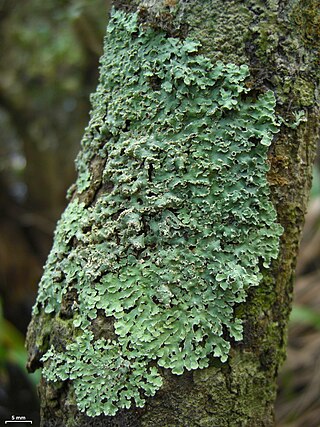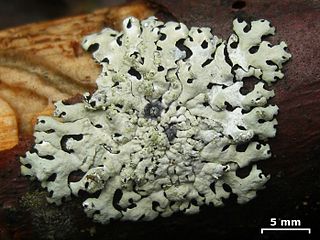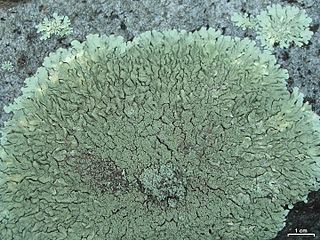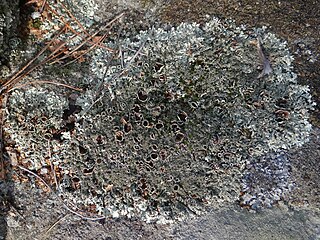
Parmelia is a genus of medium to large foliose (leafy) lichens. It has a global distribution, extending from the Arctic to the Antarctic continent but concentrated in temperate regions. There are about 40 species in Parmelia. In recent decades, the once large genus Parmelia has been divided into a number of smaller genera according to thallus morphology and phylogenetic relatedness.

The Parmeliaceae is a large and diverse family of Lecanoromycetes. With over 2700 species in 71 genera, it is the largest family of lichen-forming fungi. The most speciose genera in the family are the well-known groups: Xanthoparmelia, Usnea, Parmotrema, and Hypotrachyna.

Flavoparmelia caperata, the common greenshield lichen, is a foliose lichen that grows on the bark of trees, and occasionally on rock.

Flavoparmelia baltimorensis, the rock greenshield lichen, is a medium to large foliose lichen with a yellow green upper thallus surface when dry; its lobes are rounded without pseudocyphellae; and the upper surface is covered with globose, pustule-like growths resembling isidia. The lower surface is black with a narrow brown zone at the margins.

Caloplaca is a lichen genus comprising a number of distinct species. Members of the genus are commonly called firedot lichen, jewel lichen. gold lichens, "orange lichens", but they are not always orange, as in the case of C. albovariegata. The distribution of this lichen genus is worldwide, extending from Antarctica to the high Arctic. It includes a portion of northern North America and the Russian High Arctic. There are about thirty species of Caloplaca in the flora of the British Isles.

Physcia is a genus of lichen-forming fungi in the family Physciaceae. The widely distributed genus contains about 80 species. The genus is cosmopolitan, and has been extensively studied in various regions in the past several decades, with significant biodiversity in South America identified as a central diversity hotspot. Physcia species are foliose, lobate lichens that grow with a loose to close appressed habit. Their upper surface is typically whitish, pale greenish, green-grey, or dark grey in colour. The thallus colour remains relatively unchanged when moistened. Physcia lichens typically grow on bark, on wood, or rock, although they have occasionally been recorded dwelling on man-made structures. They thrive in nutrient-rich environments and are expanding rapidly in urban areas of the United Kingdom previously affected by SO2 pollution.

Myelochroa is a genus of foliose lichens in the family Parmeliaceae. They are commonly known as axil-bristle lichens. It was created in 1987 to contain species formerly placed in genus Parmelina that had a yellow-orange medulla due to the presence of secalonic acids. Characteristics of the genus include tightly attached thalli with narrow lobes, cilia on the axils, and a rhizinate black lower surface. Chemical characteristics are the production of zeorin and related triterpenoids in the medulla. Myelochroa contains about 30 species, most of which grow on bark. The genus has centres of distribution in Asia and North America.

Hypotrachyna is a genus of lichenized fungi within the family Parmeliaceae. According to the Dictionary of the Fungi, the widespread genus contains about 198 species. Hypotrachyna was circumscribed by American lichenologist Mason Ellsworth Hale Jr in 1974.

Flavoparmelia is a genus of foliose lichens in the family Parmeliaceae. Because of their appearance, they are commonly known as greenshield lichens. The widely distributed genus contains 32 species. It was circumscribed by American lichenologist Mason Hale in 1986 to contain 17 former Pseudoparmelia species with broad lobes, usnic acid in the cortex, and isolichenan in the cell walls.

Xanthoparmelia is a genus of foliose lichens in the family Parmeliaceae. This genus of lichen is commonly found in the United States, as well as Australia, New Zealand and Ecuador.

Xanthoparmelia conspersa, commonly known as the peppered rock-shield, is a foliose lichen and the type species of genus Xanthoparmelia. It is widely distributed in temperate zones, and has been recorded from Japan, Europe, Africa, North America, and South America.

Xanthoparmelia mexicana, commonly known as the salted rock-shield, is a foliose lichen in the family Parmeliaceae. It grows in 4–10 cm diameter rosettes of gray-green to yellow-green lobes in arid climates all over the world.
Remototrachyna is a genus of foliose lichens in the large family Parmeliaceae. It was separated from the genus Hypotrachyna based on the structure of the excipulum and genetic differences.
Arctoparmelia separata, commonly known as the rippled ring lichen, is a species of foliose, ring lichen in the family Parmeliaceae with a roughly circumpolar distribution.

Parmotrema rampoddense, commonly known as the long-whiskered ruffle lichen, is a species of foliose lichen in the family Parmeliaceae. It is widely distributed in tropical regions and grows on the bark of oak and palm trees.
Hypotrachyna bogotensis is a species of foliose lichen in the family Parmeliaceae. It was first described scientifically by Finnish lichenologist Edvard August Vainio. Mason Hale transferred it to the genus Hypotrachyna in 1975. It is a common species in the high mountains of the Central America and the northern Andes. It has also been recorded from southern Chile and from Gough Island.
Hypotrachyna brevirhiza is a species of foliose lichen in the family Parmeliaceae. First described as a species of Parmelia by Syo Kurokawa in 1964, Mason Hale transferred it to the genus Hypotrachyna in 1975. The lichen is widespread in Central American Mountains and in the Andes at elevations of 2,700–4,300 m (8,900–14,100 ft), where it grows as an epiphyte on exposed trees and shrubs. It also occurs in southern South America, Africa, India, Indonesia, Papua New Guinea, Macquarie Island, and the Pacific.

Flavopunctelia flaventior is a species of foliose lichen in the family Parmeliaceae. It was first formally described as a new species by James Stirton in 1877 as Parmelia flaventior. In 1982, Hildur Krog transferred it to the subgenus Flavopunctelia of her newly circumscribed genus Punctelia, created to contain Parmelia species with punctate (point-like) pseudocyphellae. Mason Hale raised this subgenus to generic status a couple of years later, setting Flavopunctelia flaventior as the type species of the new genus. The lichen is commonly known as the speckled greenshield. Flavopunctelia flaventior occurs in Asia, Europe, East Africa, North America, and South America.

Hypotrachyna osseoalba, commonly known as the grainy loop lichen, is a species of foliose lichen in the family Parmeliaceae. It is widely distributed in subtropical and temperate areas of the world. Characteristic features of the lichen include the pustules in its cortex, the somewhat linear shape of the lobes comprising the thallus, and the branched rhizines.

The following outline provides an overview of and topical guide to lichens.














